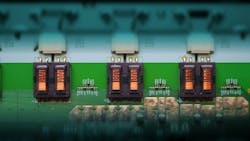Where Isolation Fits into Next-Gen Power Electronics
High-voltage isolation plays a much more critical role in modern power systems. The primary goal of galvanic isolation is to prevent unwanted DC or any sudden AC current from entering different sections of a power supply or other system, while enabling the safe transfer of power and signals. If any failure occurs in the system, isolation is in place to prevent the hazardous high voltage from reaching the low-voltage electronics.
In power supplies, transformers are widely used to isolate high voltages at the input end of the control or output end of the system for purposes of reliability and safety. Other isolation “barriers” can also be based on optical, inductive, or capacitive isolation technologies. In electric vehicles, high-voltage battery packs are isolated from the low-voltage electronics by various isolated links within the subsystems. Data-center power-supply units (PSUs) must be protected the same way from the increasingly high AC voltages used for power distribution.
But as high voltages become more prevalent in power electronics, semiconductor companies are baking more robust isolation into more of the power supply’s components to make sure everything runs efficiently. For instance, Skyworks Solutions integrates its silicon isolation technology into everything from gate drivers for power switching and analog ICs for current and voltage sensing to digital isolators that can support isolation voltages as high as 5 kV.
These chips are galvanically isolated for safety as well as reliability. One of the responsibilities of isolation is to prevent electric shocks, keeping high voltages from straying into the sections of the system where they can harm anyone too close. In addition, robust isolation protects power components from transients and any other unplanned, abrupt spikes in voltage, which have the potential to be hazardous to the system.
These isolation devices can also assist in preventing electromagnetic interference (EMI) and other types of electrical noise from interrupting power-supply signals used to control high-efficiency DC-DC and AC-DC converters.
Furthermore, galvanic isolation is used to break ground loops, which can increase EMI in the system. With several power supplies and control paths in a system, slight discrepancies in ground potential can lead to ground loops. These ground loops are broken by isolating specific portions of the circuit, curtailing noise.
>>Check out this TechXchange for similar articles and videos
To explore how power electronics are evolving and the role that galvanic isolation is playing, we reached out to John Wilson, senior product line manager, and one of the experts on the intersection of power and isolation, at Skyworks.
This interview has been lightly edited for clarity.
From the onboard chargers (OBCs) and DC-DC converters in EVs to renewable-energy equipment, it seems like power systems across the board are hitting higher power levels. What challenges are engineers facing? What are characteristics to keep in mind when designing in these situations?
For onboard chargers and DC-DC converters, challenges for engineers include power-per-volume, performance, and cost. One metric is the amount of power converted, inverted, or generated per unit of module volume, which everyone knows as power density. There are pressures to reduce the chassis size to consume less space in the motor compartment yet deliver the same or higher power than the previous design.
Performance indicates the ability to improve efficiency of the conversion by, for example, increasing switching speeds in the half-bridge power supplies in the design. And cost is always a consideration, getting more done for less money through BOM improvements or superior components.
For industrial sectors like motor control, solar and wind inverters, EV fast chargers, and power supplies for data/AI servers, there is a much higher demand for electrical power. Coupled with stringent energy-efficiency requirements regulated by governments across the world, designers of such systems need to squeeze every drop of power out of the systems as output. Wasted power manifests as heat, therefore increasing energy efficiency also reduces cooling costs. As in automotive applications, higher efficiency is a key metric.
In each of these three factors of power density, performance, and cost, a key isolation component is gate drivers. By increasing switching speed in a way that neither generates nor is susceptible to noise, and works compatibly with the latest technology FETs such as SiC and GaN, the isolated gate drivers make a critical contribution to increased power density, increased performance, and lowered system cost.
Skyworks introduced isolated analog devices that can obtain precise measurements of current and voltage in power control systems. What problems are they addressing?
Skyworks is on its second major generation of isolated amplifiers for current sensing with shunts. We leveraged years of field experience from the first generation to make assorted improvements, including lowering signal delays, reducing measurement drift, increasing CMTI, and adding a digital bitstream output option called Delta-Sigma Modulation (DSM). So, we addressed everything from electrical isolation, noise immunity, response time, accuracy over temperature, and flexibility in either analog or digital interfacing.
These isolated current sensors—the Si8921/22 and Si894x—are complemented by the Si893x isolated voltage sensor. The devices feature single-ended inputs and a variety of outputs including single-ended and differential analog, as well as the DSM output. The circuit innovations we developed lead to better precision in measurements, lower drift across temperature, large dynamic range, and low-noise performance.
Why is it important these analog devices are isolated in the first place? What’s the risk of inaccurately measuring current and voltage in a power control system?
There are three major factors for including isolation considerations in a design: safety, noise immunity, and level shifting. For safety, isolation protects electronics and people from potentially dangerous elevated voltages.
Take a half bridge power supply with a DC voltage rail of 400 V. It will not play nicely with 12-V and below electronics. The 400-V rail will damage the lower-voltage circuits, rendering the electronics useless at best, and dangerous at worst. Isolation provides protection in this case, as well as keeping people protected. If, for example, the 400-V rail is also accompanied by significant current behind it, then a shock or even electrocution are possible.
A second need is noise immunity. If one ground domain of a system is switching noisy, high-voltage and high-current FETs or IOs and an adjacent domain has sensitive analog-to-digital converters and MCUs, yet those two domains require control and feedback signal to flow between them, isolation is essential. Without isolation, measurements will be interfered with, signals will be distorted or lost, and digital communication can become garbled. Robust isolation with high CMTI will ward off these noise-immunity perils.
Lastly, level shifting. When digital communication needs to take place between a domain with 3.3-V logic and another with 5-V logic, a digital isolator with appropriate power supplies on each side can provide successful signal conveyance to, or from, these domains. It assures control and feedback data is properly conveyed, with signals shifted into the corresponding domain’s levels.
How has Skyworks’ isolation technology evolved in recent years? What are some of the key features or attributes that you’re working into these isolation devices?
Power efficiency is a key metric. At the same time, safety is a critical concern, given the high capacity of such systems. We are developing gate drivers, sensors, and digital isolators with features that help boost power efficiency while [adding] monitoring, protection, and safety against dangerous fault conditions. These parts have evolved over the years to provide a higher level of safety isolation as the magnitudes of the voltages and currents involved go up. The latest products are rated at the highest level in the industry.
What challenges are AI data centers presenting to power engineers, and how are isolation devices helping to tackle these problems?
AI data centers present a unique challenge. The graphics processing units (GPUs) and other AI chips burn much more power than conventional data server processors. The challenges are two-fold. First is ensuring high efficiency to keep energy costs and cooling costs low. Second is keeping everything compact. That is key to maximizing the processing capacity for a given footprint.
Wide-bandgap power switches such as GaN are now gaining ground on silicon switches due to their intrinsic capacity for switching at a higher rate, which translates to less power loss. In a lot of cases, gate drivers [with robust isolation] must be specially designed to meet the unique challenges presented by faster GaN switches.
>>Check out this TechXchange for similar articles and videos
About the Author
James Morra
Senior Editor
James Morra is the senior editor for Electronic Design, covering the semiconductor industry and new technology trends, with a focus on power electronics and power management. He also reports on the business behind electrical engineering, including the electronics supply chain. He joined Electronic Design in 2015 and is based in Chicago, Illinois.


